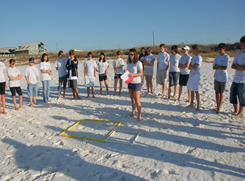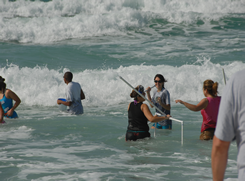AFRICA TRIP
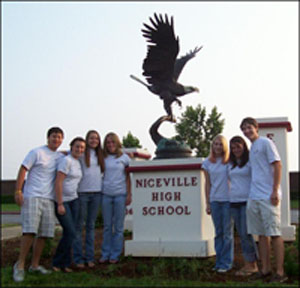 |
This is the Niceville High School NaGISA Tanzania Team.
From left to right: Jonathan LeMoel, Jordan Ezell, Ann Durrenberger, Lauren Foy, Cyndi Milum, Cami Fletcher and Nick Stinnett
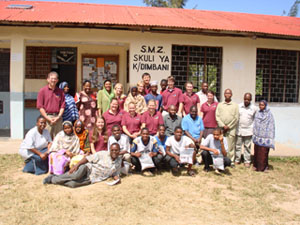 |
Niceville High School NaGISA team with their counterparts from the Kizimkazi Dimbani, Zanzibar, Tanzania.
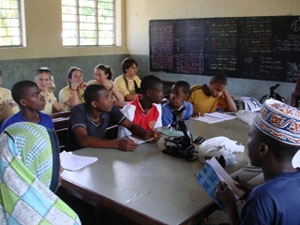 |
Students from both teams listening to instructions on how to do the NaGISA Protocol
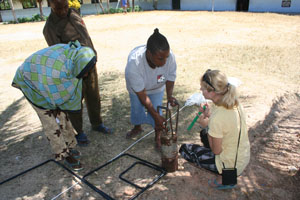 |
Here the African students are demonstrating their understanding of the use of the collection grids
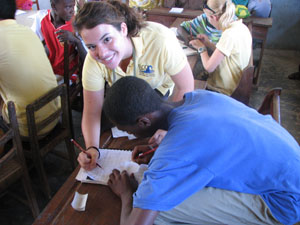 |
Cami Fletcher assisting an African student with a specimen identification exercise
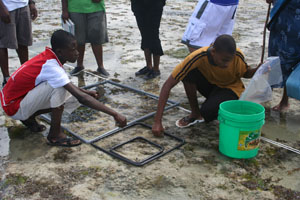 |
Students from Kizimkazi Dimbani School collecting specimens at the shoreline site
Trip to Tanzanian journal
Training
Our first meeting with the Tanzanian students was on Sunday, August 12, 2007. Dr. Margareth Kyewalyanga (Maggie) of the Tanzania Institute for Marine Science and her team met our group at the hotel and walked us over to the school where the headmaster, the science teachers, and the students were waiting. There were a total of 10 students that were going to be participating of which 7 were boys and 3 were girls. We went around the room introducing ourselves, and then discussed the plan to start the NaGISA training the next day.
The following day, we met the students and teachers at the school again, and gave them basic background information on NaGISA (how it started, why it is important, why they should participate). After this brief explanation, we began the process of motivating the Tanzanian students to encourage them to be involved in the project. Once it had been explained to the students what they could expect for the next few days, we asked them to name some of the organisms they thought they would be encountering while we did our collection. Their answers consisted of large sea animals that they typically see, but nothing microscopic. Our purpose in doing this was to show the students at the end how many more organisms live in their waters than what they think. After this, we went to survey the pristine area where the sampling would be taking place. The designated sampling area posed a problem for us their shore is an intricate mixture of sea grass and rocky shores. After discussing the issue, we decided that the best way to handle it was to create a new protocol which combined the sea grass protocol and the rocky shores protocol. We went back to the school when we had finished assessing the site, and it was decided that a game that would break the ice between our two groups would be very beneficial. For this game everyone paired off with one or two people from another group, introduced themselves, and was required to learn two things about their new friend. We then went around in a circle, and each pair introduced their friend to the rest of the group.
Day 3 started the in-depth training. The morning consisted of making a list of all the equipment that was necessary for a collection, and then labeling the collection jars so things would be organized for the next day (the equipment had already been built for the students). During lunch, the NHS teachers and the Tanzanian adults sat down and discussed the options for how to do the collection on the varied shoreline. They created a protocol that mixed the sea grass and rocky shores protocol. Our teachers had to quickly teach us the new protocol during lunch so that we would be capable of explaining it to the Tanzanian students. After lunch, the groups split into two, with half of the students receiving microscope training and the other half receiving protocol training. It was phenomenal to watch the students look through the microscope for the first time, and say that they now knew that their teachers were not lying to them when they talked about microscopic organisms. Once each group had been sufficiently trained on their respective topics, the groups switched and were trained on the other topic. With the help of a translator, the students picked up on the protocol remarkably fast. That night, Dr. Edward Kimani of the Kenya Marine and Fisheries Research Institute who is also the NaGISA Indian Ocean Regional Coordinator arrived in Kizimkazi. Our group practiced the protocol again that night to make sure everything was going to go smoothly the following day during the collection.
Collection
The students met us at the site early Wednesday morning to start the collection. Upon further investigation, Dr. Kimani proposed that we do the rocky shore protocol at high and mid tide and the sea grass protocol at the 1 meter depth. We then explained the new changes that were being made to the Tanzanians students. They took the adjustments very well and did exceptional with the shoreline collection. After completing the shore collection we proceeded with the 1 M depth collection. Once everyone had taken their 1 M samples, it was decided that it would be beneficial to start some of the sorting while on the beach so that we did not have to haul salt water to the school. After lunch, we went back to the school to continue the analysis. Everyone stayed at the school working until it got too dark to see.
On Thursday morning, we finished the processing from the day before. Afterwards, we went back to the sampling site to do the high tide rocky shores collection. Again, the Tanzanian students did wonderfully with the collection. When we were finished with the collection, we went back to the school to process the samples we had just taken and continued work until it got late. Due to issues with the wiring of the microscopes and a lack of electricity, we had still not been able to begin looking at any of the samples through the microscope.
The processing of the remaining rocky shore samples was finished on Friday. Midmorning, two of our Niceville students, the grad student from the University of Southern Mississippi, and Dr. Kimani left to do the dive collection. Two Tanzanian students were also taken to assist with the handling of the samples on the boat. Chiefly due to the amount of air available for the dive, only the 5M collection was accomplished. A few logistics problems arose with the dive collection, but all the samples were eventually taken. Back at the school, the processing of the rocky shore collection was being finished. Once the dive samples were brought back to the school, we were able to start processing them that afternoon.
On Saturday, we finished processing the 2cm samples from the dive. Any micro fauna found in the samples were taken to the Institute of Marine Science for analysis under the microscope because there were still issues with the electricity at the school. After the completion of our processing of the sample, we had a closing discussion with the students and teachers. We asked them what they thought about the NaGISA project, and what could have been done better. Everyones response was very positive they all said how glad they were to have had the opportunity to participate in NaGISA and to have met our group.
On Saturday afternoon we had the goodbye lunch. A few guests from the village attended and many speeches were made. At the conclusion of the speeches, we donated the 4 microscopes which had been generously provided by Okaloosa Walton College (a local college in Niceville, Florida) for our joint use during the analysis phase of the project as well as many other useful items all of which were presented to the school and village for their use. Some of the items provided in addition to the microscopes were mosquito nets, medicine, toiletries, clothing, shoes and school supplies. Following this, a traditional African meal was made for us. During the meal we had an opportunity for a few last laughs with our new friends before having to say goodbye.
Reflections
Overall, the trip was a huge success. The Tanzanian students really picked up on NaGISA procedures quickly and were incredibly motivated about all aspects of the project. There is no question that the student to student teaching technique we used was very effective.
From the Niceville High School perspective, it was very interesting to see the differences in our shorelines. Our Northwest Florida shore could be referred to as an aquatic desert. We have very little biodiversity on our coast, whereas, comparatively, the shore at Kizimkazi is essentially an aquatic rainforest with seemingly endless amounts of creatures filling the tidal pools.
Again, in our view, both sides gained a vast amount of knowledge not only about science, but also about the cultural similarities and differences. Our trip to Tanzania has most definitely helped expand the NaGISA high school initiative, and has created a new sampling site for future NaGISA collections. We have helped instill an interest in science which will permanently impact the lives of the Tanzanian students just as their generosity, enthusiasm, positive outlook on life and selflessness will have a lasting influence on all of us from Niceville High School.
As a result of the success of this Tanzania trip, we feel that NaGISA now has a blueprint for further expansion of the NaGISA high school initiative. The students and faculty of Niceville High School stand ready to assist with further expansions in any part of the world.

